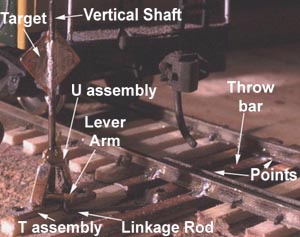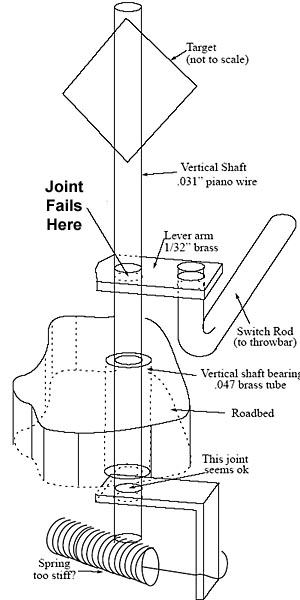 |
 |
 |
 |
 |
 |
Twist and Shout! |
|
|
How do I build one of these buggers? If after reading the above disclaimer you still wanna try building some switch stands here are some instructions.  Switchstand Parts Names 1. Take a piece of brass L channel (3/32" x 3/32") and lay it "V" down in a groove. 2. Use a triangle cross section jewlers file to make to cross ways grooves in it going nearly all the way through. Make the two cross grooves about 1/10" apart. 3. Bend the L channel at the new cross grooves to form a sort of U shape. 4. Solder the joints (use silver solder). 5. Drill a .035" hole in the bottom of the U for the vertical shaft to pass through. Now cut off the ends so it will stand upright like an upside down V with a flat bottom. Make the top of the upside down V (or U) about 1/4 to 5/16" high. This is a matter of appearance. 6. Take a piece of brass bar stock about 1/32" x 3/32" x 3/4" and drill a hole about .050" in the middle. 7. Cut a length of .047 brass tube about 1" long (should be slightly shorter than your roadbed thickness plus tie thickness.  Switch Stand operating parts schematic |
8. Solder the tube into the hole of the brass bar from step 6. Make a T shape with about 1/32" of tube protruding above the brass bar. 9. Cut a piece of .031 piano wire about 2.5" to 3.5" long. 10. Drill two holes in a piece of brass bar about 1/32"x1/16". Make one of the holes .035" and the other .028". Make the two holes about 0.8 times the throw distance of your turnout. 11. Cut off the lever arm from step 10 just beyond each hole. 12. Solder the lever arm to vertical wire from step 9 about 1" from one end. 13. Thread the lever arm and shart assembly into the tube from step 7. Make sure the lever is at the top of the "T" assembly. 14. Thread the stand superstructure onto the vertical shaft and solder the legs to the top of the "T" assembly being careful not to solder the staft to the tube. When done you should have the lever arm on the shaft enclosed in the upside down U shape. Some of the brass bar (top of the T assembly) shold protrude beyond the legs of the upside down U. 15. Go to the turnout where you'll be installing the turnout and drill a .050" hole about 8 scale feet (1 1/16") from the track center line in one of the switch ties. This hole should be as perfectly vertical as you can manage to avoid having the switchstand "tilted" when installed. 16. Push the assembly from step 14 into the hole to test fit it. Look underneath. If any tube protrudes from the roadbed remove the assembler and using wire strippers carefully take off enough tube so the tube end is about 1/16" above the bottom of the roadbed. 17. Remove the assembly and drill .030 in the ends of the U/T assembly (from step 14 and 16) for mounting spikes. 18. Place the assembly back in the hole. Carefully cut and bend a piece of .025 piano wire so both ends bend up at right angles and the length between them is **exactly** the distance from the hole in with turnouts switch rod and the hole in the end of the lever arm attached to the vertical shaft. Make sure both the lever arm and the turnout points are positioned in the CENTER of their travel! 19. Attach one end of the linkage wire from step 18 to the turnout throw rod. Slide the switch stand up and then down so the lever arm hole accepts the other end of the linkage wire. 20. Cut a piece of brass or phosphor bronze sheet (.008") about 1/4" sqaure (or round or other shape) for the switch stand target. 21. Set the turnout to its "normal" route. 22. Solder the target to the vertical shaft so it is parallel to the track. 23. Twist the target 90 degrees with your fingers. The turnout should throw to the diverging route and the target should now be at 90 degrees to the normal route track. 24. Cut a piece of brass bar 1/32x3/32x1" for a spring lever. Drill a hole very near one end about .035". Bend it into an L shape about 5/16" to 3/8" from the hole. 25. Drill a second hole at the other end of the L shaped spring lever. About .030" 26. Go under the layout and slide the .035 hole onto the vertical shaft under the roadbed with the other L arm aiming down. Solder in place. The reason the tube of the T assembly was cut so its bottom is 1/16" away from protruding below the layout is so when the spring lever is soldered in place it won't solder the vertical shaft to the tube! 27. Throw the spring lever back and forth and note its range of travel. Mark the center of this range. Make a line (imaginary is fine) from the center of travel mark past the vertical shaft and drive a 5/8" #4 sheet metal screw into the roadbed. 28. Use a moto tool to cut off excess vertical shaft under the spring lever (L) arm. 29. Stretch a spring from the bottom of the spring lever arm to the screw from step 27. 30. You're done. Twisting the target should now "snap" the turnout from one side to the other. If its really hard to twist move the screw closer to the vertical shaft. If it wants to always throw in one direction move the screw to the other direction under the roadbed. |